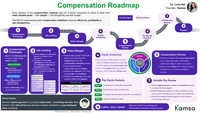
Compensation Playbook Cheat Sheet
Early adoption of this compensation roadmap pays off. It allows companies to attract & retain their most valuable asset — their people — and thoughtfully use their budget.
The ROI for implementing these compensation initiatives enhances efficiency, profitability & pay transparency.
-
Compensation Philosophy
- Select the market percentiles you plan to target by job family. For example, meet the market by targeting the 50th percentile for non-technical jobs (due to a larger talent pool) or lead the market by targeting the 65th or 75th percentile for technical jobs (typically requires a special skill-set).
- Select the market data cuts to use by work location.
-
Job Leveling
- Identify level criteria (compensable factors) to include in level definitions
- Establish concise level definitions for each job level (for both individual contributor and management tracks)
- Map all employee’s jobs to a level, focusing on the job, not the individual
-
Salary Ranges
- Develop salary ranges for each job family by job level, where the midpoint aligns with the compensation philosophy chosen
- Acquire reliable market compensation data like Kamsa.com
- Establish the minimum of the range by taking 85% of the midpoint
- Establish the maximum of the range by taking 115% of the midpoint
-
Equity Guidelines (optional)
- If your company offers equity (e.g., stock options), establish guidelines for new hires & refresh grants using market equity data
- Model out & budget shares you need for the year, and it’s respective dilution rate
-
Compensation Review
- Provide your leaders with various data points (e.g., market salary data, current salary, performance rating) to make pay decisions.
- Model out and budget cash needed for salary increases (e.g., for merit & promotions), annually.
-
Pay Equity Analysis (optional)
- Step 1: Calculate each employee's compa-ratio
- Step 2: Bucket by job family, job level, & job
- Step 3: Find gaps using average compa-ratio for comparison
- Step 4: Document reasons for gaps
-
Variable Pay Review (optional)
- Review target amounts for bonus & commission against the market for those eligible
- Establish pay mix guidelines for sales employees by role, and use them consistently (e.g., for offers and promotions)
- Assess the design of incentive plans to ensure they are driving desired behaviors
-
Repeat!
- Start over with #1 by reviewing your compensation philosophy at least annually
About Kamsa
Kamsa's hybrid approach to providing market data + consulting services helps leaders make data-driven pay decisions & allows companies to pay employees fairly, painlessly.



